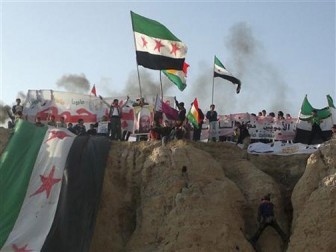BEIRUT, (Reuters) – Syrian security forces shot dead 25 people yesterday, including in cities being visited by Arab League monitors to check whether President Bashar al-Assad is keeping a pledge to end a crackdown on popular unrest.
The Arab League hopes its deal with Assad can stop nine months of bloodshed. More than 5,000 people have been killed, by a United Nations count, provoking international sanctions against Damascus and stoking fears of civil war.
Anti-Assad activists have said the monitoring mission is too small and easily restricted by state security escorts that many protesters are afraid to approach. There have also been questions about the chief of mission, a Sudanese general whose government has defied an international war crimes tribunal over bloodshed in Darfur.
The Syrian Observatory for Human Rights said Assad’s security forces opened fire on protests in cities around the country, wounding around 100 people. Six died in Hama, a major hotbed of unrest, around the time monitors were entering the city for a first look.
The British-based Observatory said security forces fired at a street rally in Douma, a Damascus suburb, killing four people. Enraged residents launched a civil disobedience campaign and thousands reportedly flooded the main square for a sit-in.
“The activists have called for complete civil disobedience. The roads have been blocked, stores are shut down and the city is paralysed,” said Rami Abdelrahman, head of the British-based Observatory.
LACK OF FAITH

Monitors aim to check conditions in the turbulent cities of Deraa, Hama and Idlib, which lie along a 450-km (280-mile) arc from the south to the north of Syria.
But anti-Assad activists in all three cities said they have yet to see the monitors.
At its midpoint is Homs, where the Arab League mission had a controversial start when its Sudanese chief, General Mustafa al-Dabi, reported seeing “nothing frightening” in an initial tour.
The general said his team still needed more time to judge conditions, but Syria’s foreign ministry spokesman Jihad Makdesi said his comments reflect the “true story of the Syrian crisis”.
The Arab mission is the first notable international involvement in Syria’s crisis. The uprising against 41 years of rule by the Assad family was inspired by other Arab popular revolts that have overthrown three dictators this year.
In Hama, activists said protesters went out into the streets to await the Arab League delegation as security forces deployed heavily in the area.
“People really hope to reach (the monitors). We do not have much access to the team. The people stopped believing anything or anyone now. Only God can help us now,” said Abu Hisham, an opposition activist in Hama.
In a video uploaded yesterday, activists filming snipers lurking on rooftops appeared to come under fire and then turned their camera to show protesters carrying away a wounded man, a trail of blood dripping behind him.
It was impossible to verify the footage or reports on the ground. Most foreign journalists are banned from the country.
Another video dated from yesterday showed a crowd of protesters in Hama watching plumes of black smoke rising from buildings nearby as heavy gunfire shook the area.
Hama has a haunting resonance for Syrians opposed to Assad. His late father ordered a massacre of up to 30,000 people there in 1982 to put down an Islamist insurrection.
COMMUNICATIONS DIFFICULT
A source in the Arab League mission’s operations centre in Cairo said earlier yesterday there had been a problem with communications but the monitors’ schedule was holding up.
“We have contacted our teams … Today’s plan will not be changed and the only problem we faced today was the bad phone network, which made our communication with the monitors harder. It took more time to reach them and determine their locations.”
The Syrian foreign ministry spokesman said Arab monitors were getting “all the facilities they need” to assess the crisis.
Activists in Idlib said they had tried to reach out to the delegation with little luck.
“We got five numbers but the reaction we got from those people made us feel they were pro-regime. However, three monitors have contacted us to say they plan to visit us secretly, in private,” said an activist named Munahal. “They can’t bring their team, that means the security would come too.”
Unless it can establish its credibility by proving it has unobstructed access to all areas and is able to hear uncensored accounts, the Arab League mission may not be able to satisfy all sides that it can make an objective assessment of the crisis.
Syria says it is fighting Islamist militants steered from abroad who have killed over 2,000 of his security force.
“WHERE WERE THEY?”
In Homs, Syria’s third-largest city and epicentre of anti-Assad ferment, protesters were already fed up with the monitors, who they said seemed unsympathetic and hard to find.
“This mission is a big lie. They say they were in Khalidiya neighbourhood. I haven’t seen them,” said Tamir, shouting by telephone over protester chants of “down with the regime”.
“We’ve been here at the protest. Where were they?”

